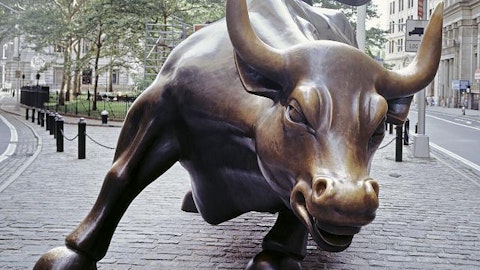Dow Chemical Co (NYSE:DOW) is in the midst of a transformation spearheaded by hedge fund manager Dan Loeb. In 2014, Loeb wrote that Dow Chemical Co (NYSE:DOW) was under-earning its potential by $2.5 billion in EBITDA annually because the global chemicals producer was too focused on making downstream products rather than maximizing profits. Loeb, whose fund owns 23.5 million Dow Chemical shares as of the end of September, wanted management to cut costs and divest its lower-margin divisions.

In response, Dow Chemical Co (NYSE:DOW) management initiated a $1 billion savings program in late 2014, divested its chlorine business in a $5 billion cash-and-stock deal in early 2015, and is considering divesting its agricultural sciences unit, which analysts think could yield up to $15 billion.
Follow Dow Chemical (Old Filings) (INDEXDJX:DOW)
Follow Dow Chemical (Old Filings) (INDEXDJX:DOW)
Because of the newfound attention on cost control, Dow Chemical’s third quarter earnings were pretty good. For the quarter, Dow Chemical earned $0.82 per share on revenues of $12.04 billion, beating earnings estimates by $0.13 per share. Although revenue under-performed because of the strong dollar, business was brisk, with gains in most segments. Operating EBITDA margin rose 370 basis points while cash from operations grew by 41% year-over-year to $2.5 billion. EBITDA was a healthy $2.4 billion on an operating basis.
The firm’s forward outlook is also solid. Dow Chemical Chairman and CEO Andrew N. Liveris shared this on the company’s future during the earnings release:
“Dow’s three years of consistent earnings growth demonstrates clearly that we have built a portfolio that captures growth where growth exists. In the forthcoming quarters we will continue to see growth and capture that growth in markets such as China, the U.S. and Europe, despite challenging macros in other parts of the world, such as Brazil. Our new investments are coming online at exactly the right time: Increased demand will ultimately drive oil prices higher further boosting Dow’s ability to capture and expand margins,” Liveris stated.
Dow Chemical’s stronger financial profile and assured outlook allowed management to raise the dividend it pays shareholders by 10% to $0.46 per share, giving the stock an attractive yield of 3.29%. The latest dividend increase brings Dow Chemical’s dividend to more than three-times what it was just five years ago, when the company paid a quarterly dividend of just $0.15. That gives Dow Chemical an impressive annual dividend growth rate of 25% over the last five years.
Given that Dow’s payout ratio is only 42%, the company’s investment grade credit rating, and the fact that free cash flow will increase as Dow winds down its growth capital expenditures, Dow Chemical’s dividend is sustainable. Given that analysts see Dow Chemical’s EPS rising by an average of 8.1% a year over the next five years, Dow’s dividend should grow by around the same rate. If crude prices normalize, growth could be even faster. If Dow Chemical sells its Agricultural Sciences unit, shareholders could be in line for a special distribution too. The strong dividend growth and more-durable, higher-margin revenue mix makes Dow Chemical a good bet.
According to our data from around 730 elite funds, hedge funds were bullish on Dow Chemical Co (NYSE:DOW) in the second quarter. 65 funds reported owning Dow stakes worth $5.86 billion, representing 9.90% of the float, as of the end of June, up from 56 funds with $4.09 billion in shares at the end of March.
Most investors don’t understand hedge funds and indicators that are based on hedge funds’ activities. They ignore hedge funds because of their recent poor performance in the bull market. Our research indicates that hedge funds underperformed because they aren’t 100% long. Hedge fund fees are also very large compared to the returns generated and they reduce the net returns experienced by investors. We uncovered that hedge funds’ long positions actually outperformed the market. For instance the 15 most popular small-cap stocks among funds beat the S&P 500 Index by 53 percentage points since the end of August 2012. These stocks returned a cumulative of 102% vs. a 48.6% gain for the S&P 500 Index (see the details here). That’s why we believe investors should pay attention to what hedge funds are buying (rather than what their net returns are).
Disclosure: None




